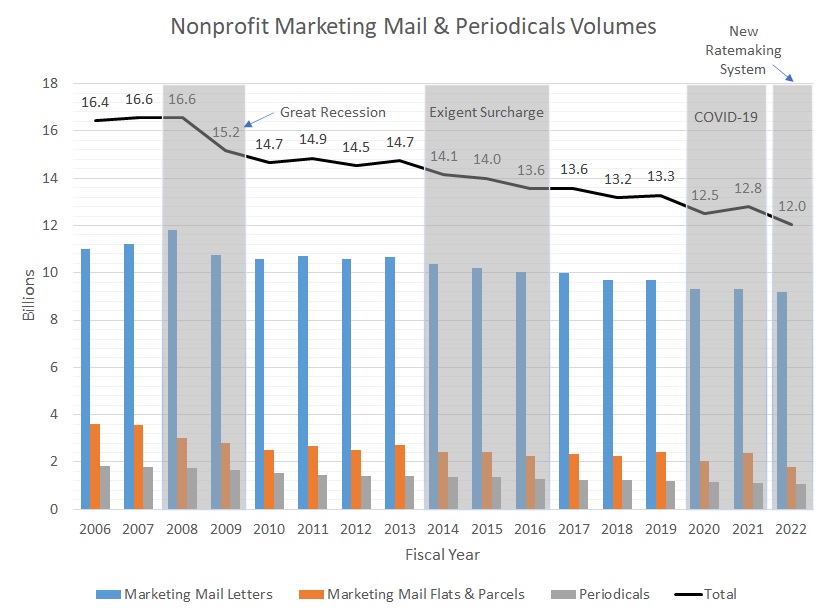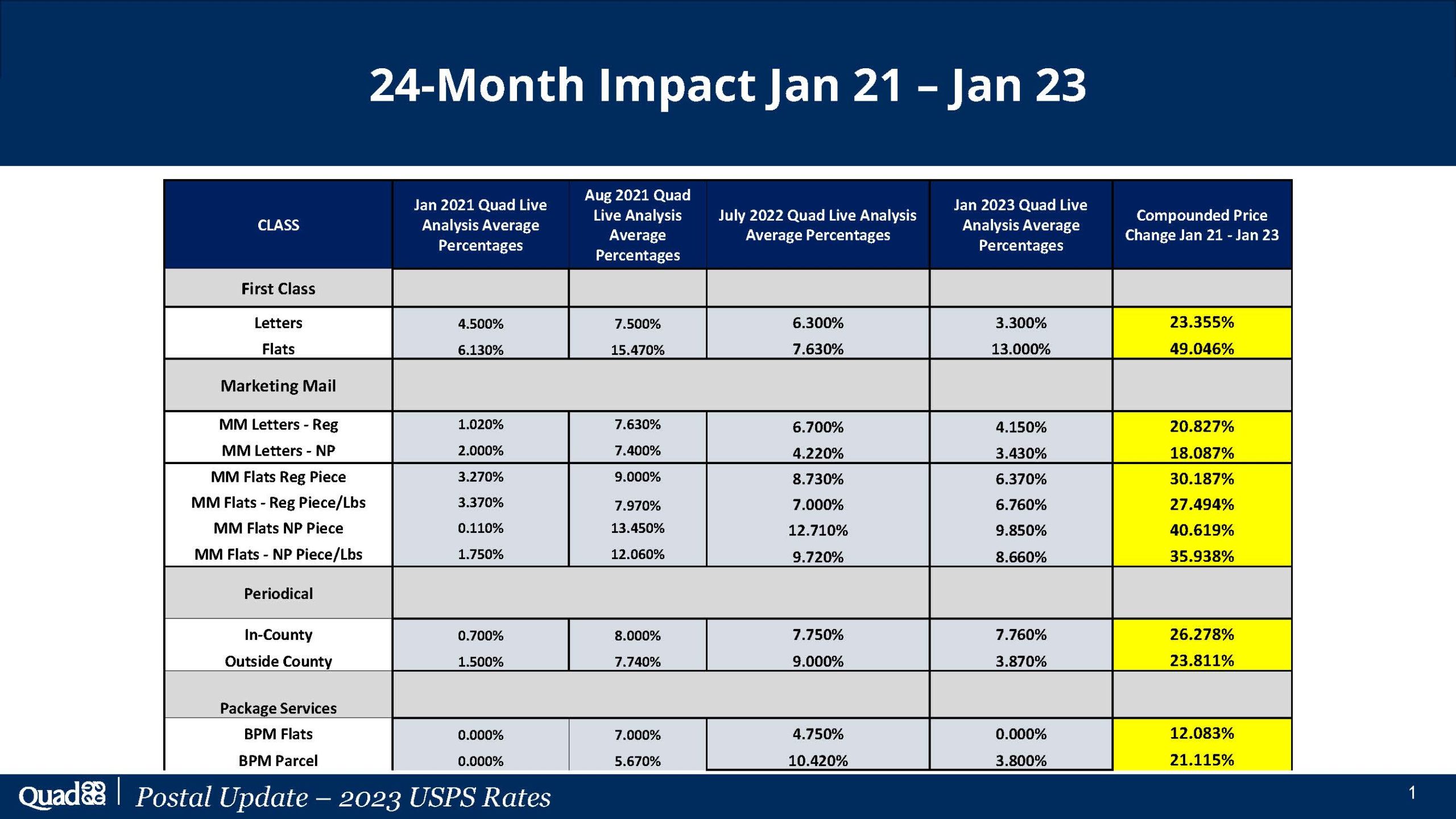Nonprofit mail volume since the peak
We have updated our data on nonprofit mail volumes since Fiscal Year 2006, the year overall mail volume peaked at 213 billion. FY 2022 ended on September 30, 2022.
We always point out that these data do not include all the First-Class Mail that nonprofits mail themselves and generate from respondents. The reason is that the U.S. Postal Service does not release such information.
We make a number of observations about nonprofit mail volume:
- While nonprofit volume dropped 27% over the 16-year period, First-Class Mail fell 50%, from 98 billion to 49 billion pieces. A 50% drop in the agency’s premier, most profitable product is noteworthy in itself.
- Overall USPS mail volume was 127.26 billion pieces in FY 2022, down from 128.84 billion the prior year, a drop of 1.58 billion or 1.2%. By contrast, last year nonprofit mail dropped by 5.8%.
- Looking at the chart above, it is apparent that nonprofit mail volume has been relatively stable during the years not affected by four major events that are highlighted. By contrast, volume fell from 16.6 billion before to 14.7 billion after the Great Recession. After four years of stable nonprofit volume, USPS received permission from the Postal Regulatory Commission to add a 4.3% “exigent” surcharge on top of inflation-based rates to recoup losses the mail agency incurred during the recession. Nonprofit volume fell from 14.7 billion before to 13.6 billion after the surcharge. After three years of solid nonprofit volume, the COVID-19 pandemic saw nonprofit mail volume fall from 13.3 billion to 12 billion pieces.
- FY 2022 ushered in the advent of a triple-demic for nonprofit mail:
- First, the PRC implemented a new ratemaking system that allows USPS to add surcharges onto the Consumer Price Index cap mandated by Congress in 2006. The surcharges include an extra 2% on non-compensatory classes of mail, most notably Periodicals, once a year. The “density” adder supercharges mail volume declines by rewarding USPS with greater rate hikes when volume declines the prior year.
- Second, USPS unilaterally decided to raise rates on Market Dominant Mail twice a year. This enables the agency to compound increases more frequently, resulting in more money extracted from mailers. It also allows USPS to upcharge non-compensatory products by 2% or more twice a year.
- And third, USPS began raising rates on non-compensatory products, most importantly Marketing Mail Flats, much more than the 2% upcharge required by the regulator.
- The FY 2022 triple-demic for nonprofit mail has implications for nonprofits:
- Nonprofit Marketing Mail letters dropped by 140 million pieces or 1.5%. The decline was muted in part by the increasing use of NPMML for the sending out of election ballots and political advertisements. Election and political mail should be reported as separate and distinct postal products.
- Nonprofit Marketing Mail flats and parcels volume plummeted by 580 million pieces, or 24.5% in FY 2022. Rate increases of about 40% mostly implemented within 18 months will do that to a postal product, especially in a price-sensitive nonprofit industry. USPS reported that its cost coverage for nonprofit Marketing Mail flats is 45% and has signaled that we can expect similar rate increases indefinitely. Rather than fixing USPS’s internal cost inefficiencies, the twin postal agencies are employing a “Sherman’s March to the Sea” that will save flats by destroying them. The 50% drop in nonprofit Marketing Mail flats over the past 16 years is matched only by First-Class Mail.
- Nonprofit Periodicals volume is down 41% over the past 16 years, -2.7% last year, and the annual 2% surcharge mandated by the PRC, begun in July 2022, will only add to the decline of the class of mail that was central to the mission of the nascent Post Office in the United States of America. Neither the USPS or the PRC knows how to get Periodicals costs under control nor how to account for all of the profitable First-Class Mail and Marketing Mail letters that are generated by what USPS used to call “the anchor to the mailbox.”
GAO finds little difference between rural and urban mail service
The Government Accountability Office was asked to evaluate whether there was a difference between rural and urban USPS service performance. In a report released January 12, GAO found little difference. Apparently, the study request was prompted by concerns that USPS service changes aimed at cost-cutting were inordinately affecting rural areas.
Looking at October 2020 through December 2021, GAO found:
“USPS had few statistically significant differences that were 5 or more percentage points in on-time service performance between rural and urban areas for First-Class Mail, Marketing Mail, Periodicals, and most packages (the four largest USPS mail products by volume). GAO found that eight of 50 districts had significant differences that were 5 or more percentage points between urban and rural areas for Periodicals, which includes newspapers and magazines (see figure below). Some of these differences favored urban areas; others favored rural areas. In one of those eight districts (the Hawaii district), GAO also found statistically significant differences that were 5 or more percentage points for First-Class Mail and Marketing Mail, all of which favored urban areas.”
Alarming USPS volume declines
The latest monthly USPS financial report for November shows alarming declines in all product volumes except “other.” Likewise, the Postal Service reported that its overall volume dropped 11% during the busy holiday season from November 26 through December 30. The agency accepted 11.7 billion letters and packages this holiday season versus 13.2 billion in the same period of 2021.
The November USPS report to the PRC shows these volume changes:
Market Dominant Nov Oct & Nov
First-Class Mail -5.5% -3.9%
Periodicals -9.6% -13.5%
Marketing Mail -8.1% -0.6%
Package Services -9.3% -13.1%
Other +17.3% +22.0%
Total -7.1% -2.1%
Competitive
Shipping and Package Services -9.9% -5.2%
Other 0.0% 0.0%
Total -9.9% -5.2%
International -9.7% -13.3%
Total Volume -7.3% -2.3%
The only bright spot was Marketing Mail in October. It includes political and election mail that was coming fast and furious with the mid-term elections.
USPS bragged in its press release that holiday delivery performance improved to an average 2.5 days versus 2.7 days last holiday season.
Still, alarm bells must be going off at postal headquarters regarding the precipitous drop in volumes across the board.
USPS reimbursed its 48 officers an average of $16,000 for travel in FY 2022
The USPS Office of Inspector General reviewed USPS reimbursement of its officers for travel in FY 2022. 48 officers spent $769,789 last year on travel for which the agency reimbursed them.
The OIG found that a sample of the travel and representation expense reimbursements totaling $156,956 were properly supported and complied with USPS policies and procedures. “Minor documentation issues” were communicated to and resolved with USPS management.
OIG recommends USPS should track delivery failures nationally
There have been many news reports, Congressional letters, and personal experiences with no mail showing up for one or multiple days in certain neighborhoods. The USPS Office of Inspector General recently looked into the Postal Service’s ability to measure and respond to these failures to deliver.
The OIG found USPS wanting in its tracking of undelivered and partially delivered routes, but was hopeful that solutions could be had using exiting tools:
What We Found
The Postal Service has tools, including Delivery Condition Visualization, Non-Delivery Survey, Mail Rotation Dashboard, and a Daily Triangulation Report, that identify delayed mail on delivery routes; however, these tools do not identify the number of undelivered and partially delivered routes nationally. Further, the Postal Service’s National Delivery Intelligence tool, which identifies assumed undelivered routes, does not provide the actual number of undelivered routes. These tools are limited due to technology constraints and reliance on the manual recording of delayed mail by delivery unit management, which is often underreported. As a result, the actual number of undelivered and partially delivered routes is unknown.
The Postal Service has opportunities to leverage existing tools and technologies to identify the actual number of undelivered and partially delivered routes. This could include integration of delivery operations data with Informed Delivery to eliminate failures to manually report delayed mail. Data on delayed mail and undelivered and partially delivered routes could be used to notify customers of delays and service outages in near real-time. Notification of service interruptions is important to inform customers and provide world-class, universal mail service.
Recommendations
We recommended management finalize system enhancements to identify undelivered and partially delivered routes and enhance processes and tools to notify customers of delayed mail and undelivered and partially delivered routes.
USPS agreed that it should finalize system enhancements to know when routes are undelivered or partially delivered. Management disagreed that it should “notify customers of delayed mail and undelivered and partially delivered routes.” It pointed to Informed Delivery as the main solution for households to know what mail is coming and to inform USPS when it doesn’t.
Surprisingly to some, USPS said in its management’s comments: “Currently, Informed Delivery® provides notifications for mailpieces arriving soon – not necessarily mailpieces arriving that same day.”
Many have been led to believe by USPS advertising that Informed Delivery tells you what mail to expect that same day. For example, the USPS website states: “Start your mornings with a preview of your day’s USPS® mail and packages with Informed Delivery® notifications.” In other places on its website, USPS hedges its bet: “Informed Delivery® is a free and optional notification feature that gives residential consumers the ability to digitally preview their letter-sized mail and manage their packages scheduled to arrive soon.”
DeJoy embraces trial-and-error
In a recent interview with Government Executive, Postmaster General Louis DeJoy embraces the approach of trying many things that might support his vision of the future for USPS, knowing that some will fail. His tone seems to differ a bit from his early complete confidence that he knew what needed to be done to fix USPS much more so than his failed predecessors. Now he bases his superiority more on his willingness to try new things an see what works and what doesn’t.
Of course, when you’re playing with house money, or more accurately mailers’ money gleaned from record rate hikes, you can afford to experiment. Thus far, the only improvements in USPS finances have come from Congressional relief and massive rate hikes enabled by a cooperative regulatory agency and 40-year high consumer price inflation.
The interview revealed the trial-and-error approach:
“A lot of people say they don’t know exactly what we’re doing,” DeJoy told Government Executive in a recent interview. “Well, neither do I.”
Again, that is a feature, not a bug. When DeJoy says he is going to “make a lot of mistakes,” it is because he is willing to adapt. He has a vision. He can see where there is $35 billion in costs to eliminate, when delivery trucks are running unnecessary routes and how to reduce turnover in the workforce. Not all of his ideas are going to work—some have already prominently failed—but he will continue pushing forward. He describes his biggest accomplishment as “juicing the place up:” namely, getting his management team and the rest of the 650,000 postal employees to embrace a mindset of change.
And when things go wrong, DeJoy and USPS will course correct.




Leave a Reply